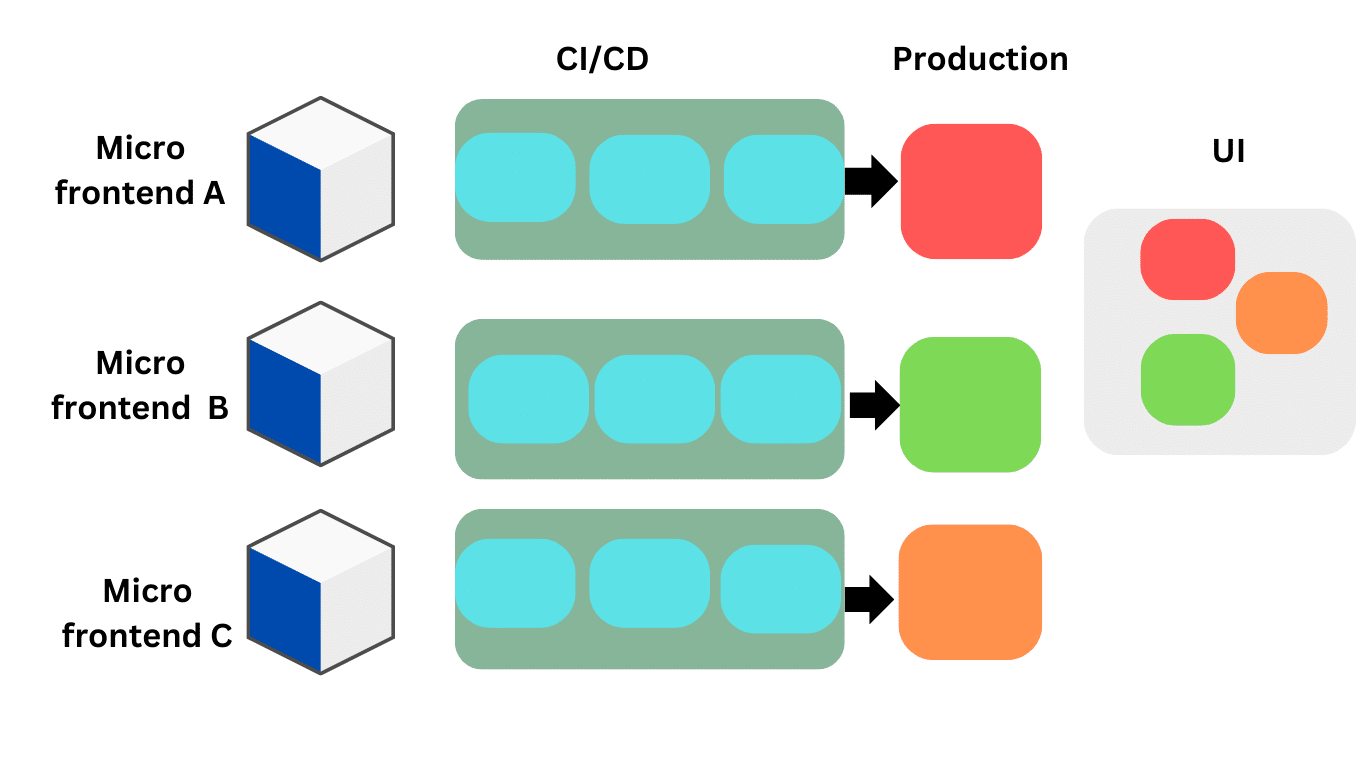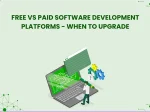Micro Frontends: The New Approach to Modular Web App Development

Over the past decade, the world of web application development has undergone a dramatic transformation. Web applications used to be straightforward, static webpages with little interactivity. Users were unable to interact with the system; they could only view information.
The arrival of JavaScript changed everything by enabling developers to build dynamic and interactive experiences. Today, modern applications include responsive designs, rich interactivity, and seamless functionality.
This transformation is driven by new software development platforms. Advanced frontend frameworks add to this shift. The JavaScript framework also boosts progress. These tools help developers create scalable and efficient online solutions.
Developers have been paying a lot of attention to Micro Frontends architecture lately. It’s changing the way people interact with complex applications. Micro frontend frameworks break down big apps into standalone parts you can actually manage.
They’re easy to build, maintain, and update without messing with the core features of the app. In this article, we’ll dive deep into Micro Frontends and break down everything you need to know. You will discover their fundamental ideas, advantages, real-world uses, and the most efficient ways to put them into practice.
The Core Concepts of Micro Frontends for Web App Development
What Are Micro Frontends?
Consider Micro Frontends as a front-end implementation of the microservices concept. You divide the app into smaller, independent parts rather than one large, densely packed app. Each piece, or module, focuses on a single feature and can be built, tested, and deployed on its own.
This setup makes teamwork smoother for developers. Multiple teams can develop different parts of the app in parallel without causing conflicts.
They can also use the tools they know best, one module might use React, another could use Angular, and another Vue. This freedom lets you choose the best micro frontend framework for every part of the project.
Micro Frontends vs. Monolithic Architecture
Traditional monolithic apps bundle everything together. That means even a small tweak can require redeploying the entire thing. One bug? It might break more than you’d expect. Adding new tech is also a headache because the structure is so rigid.
With micro frontend architecture, you avoid those pain points. Each module runs on its own, so updates affect only the parts that need changes. Developers can mix and match micro frontend frameworks without facing issues. As the traffic increases, Scaling occurs where demand is high, not throughout the system.
For good reason, this approach is becoming more and more common on existing software development platforms. Teams can operate with more flexibility thanks to it. Faster development cycles and better control over complex application management are achieved.
Also read: Everything you need to know about web application development.
The Micro Frontends Architecture
When you hear “micro frontends,” think of breaking a big app into smaller, easier-to-handle pieces. It split the whole User interface (UI) into smaller independent modules. Every module has its own function and may be developed, tested, and implemented independently.
These small pieces fit together smoothly. Whether they’re packaged during development or pulled in dynamically while the app is running.
Loading parts dynamically is great because it cuts down on initial load time. Also, it keeps things running fast.
Components and Composition
The magic happens in how you put these modules together. With a good composition strategy, everything feels seamless to the user. Even if different teams worked on different parts.
Routing plays a big role here. Whether you use path-based or URL-based routing, it needs to guide users smoothly without breaking the flow.
This is where micro frontend React and micro frontend frameworks excel. They greatly simplify the process of assembling the parts.
Communication Between Micro Frontends
Modules no longer exist in their absence. They must communicate with one another. That is made possible by event-driven systems, shared states, or APIs.
The trick is to keep this communication clean, without creating messy dependencies. When done right, users get a smooth, unified experience. Even though under the hood, it’s built on multiple micro frontends frameworks.
This method has rapidly grown in popularity in contemporary front-end development. Its scalability, easy maintenance, and use of any micro frontends framework make it stand out.
Advantages of Adopting Micro Frontends
Micro frontends are becoming a game-changer in frontend and backend in website development. They break down big apps into smaller pieces, making everything easier to handle. Let’s go through why this approach is so popular among developers today.
Independent Development and Deployment
One of the coolest perks is that teams can work on their parts separately. No one has to wait for another team to finish first.
This means updates roll out faster, and bugs get fixed quickly. It’s a huge win for anyone doing front end web development because you’re not stuck in endless dependency chains.
Enhanced Scalability and Flexibility
Traditional monolithic apps can be a nightmare to scale. Micro frontends solve that problem. Developers can scale only the parts that need more power without touching the rest.
This flexibility is crucial when you’re dealing with apps serving millions of users. It’s also why many consider this approach in web development frontend. It helps when choosing the best frontend framework for large projects.
Improved Team Collaboration
With micro frontends, teams aren’t forced into one tech stack. One group might love React, while another sticks with Ext JS, which is Extended JavaScript.
Both can work together without stepping on each other’s toes. This freedom boosts creativity and keeps productivity high. When comparing back end vs front end development, this autonomy really makes front-end work more dynamic.
User Experience and Performance Benefits
Every module in a micro frontend setup can be fine-tuned on its own. Faster load times, smoother interactions, and fewer slowdowns are the results.
Users notice the difference right away. Good performance is key to keeping them engaged. That’s why many developers lean toward this approach when searching for the best front end framework for their next project.
Best Practices for Micro Frontends Development
- Build small, independent modules. Keep them self-contained and reusable. Clear boundaries make updates and fixes way easier.
- Pick compatible tech stacks. Avoid mixing tools that don’t work well together. Choosing the best frontend webdev framework helps prevent integration issues.
- Use APIs and contracts. They let modules communicate smoothly without breaking other parts. Add versioning to track what changed and when.
- Automate your workflow. Set up CI/CD pipelines to speed up deployment. Keep monitoring performance, then tweak and refine as your front end web development scales.
Overcoming Challenges in Micro Frontends
Micro frontends are great, but they do come with their share of headaches. Combining modules built with different tools isn’t always smooth sailing. Planning is necessary to ensure that everything functions together without malfunctioning. In order to avoid the app feeling patchy, it is equally important to maintain the same design throughout all of those sections.
Another important consideration is performance. Your app may become ineffective or slow down if it receives too many requests. Caching, splitting code, and loading resources only when needed are ways to speed up a process. Additionally, test each module across different browsers to ensure consistent functionality.
Security is something you can’t overlook. Every module should follow secure coding practices to prevent issues like XSS. Frequent code reviews and audits aid in identifying issues early. Additionally, by simplifying the code, composable frontend frameworks make it simpler to maintain the security, consistency, and functionality of your application.
Also Read:Top Low-Code Platforms for Rapid Web App Development
Successful Implementations of Micro Frontends
Netflix and Spotify use micro frontends to roll out updates faster. Each team works on its own piece without conflicts. Users get a smooth experience with new features all the time.
Micro frontends help Netflix and Spotify maintain the functionality of their apps. They divided the software into smaller components to guarantee that updates happen without causing any disruptions. This method guarantees a smooth user experience while simplifying scaling.
Netflix
Netflix uses micro frontends to keep things fast and flexible. Each team owns its own module, often integrating tools like JS grid, so they can push updates without stepping on anyone else’s toes.
Scaling is made simpler and the deployment of new features is maintained with this configuration. With no downtime or bugs to cope with, users gain new experiences. It’s a smart way to move fast while keeping everything stable.
Spotify
The micro frontend strategy was adopted by Spotify as well, and it is really well. Different teams handle features like playlists, search, and more without touching the rest of the app. Thanks to its flexible setup, updates roll out quickly.
Users love that updates occur without interfering with their workflow. It never feels clumsy while maintaining the Cross-platform evolution.
Ext JS for Micro Frontends Development
Ext JS is a popular front-end framework developers use to build powerful, enterprise-level apps. It saves a ton of time because it comes with over 140 ready-to-use components. Out of the box, you have two-way data binding, cross-browser compatibility, and a safe, expandable configuration.
What makes it even better? It blends smoothly with micro frontend architecture. With this combination, developers can create high-performance, modular programs that scale effortlessly. Also, satisfy demanding enterprise needs without the typical hassles.
Teams can produce features more quickly thanks to its smooth integration and extensive user interface elements. It’s a solid choice for companies aiming to boost productivity and keep apps running flawlessly.
Comparison: Backend vs Frontend Development
If you’re starting with web development, understanding the difference between frontend and backend web development is key. The frontend is the part users interact with, including buttons, forms, and layouts. The backend runs behind the scenes, handling servers, databases, and the logic that powers the app.
To provide a smooth experience, both parties must cooperate. Without a strong backend to support it, a well-designed frontend is nothing. When they integrate well, developers can create fast, user-friendly, and scalable web applications.
Learn more about building Micro-Frontend using Ext JS here.
Conclusion
Micro Frontends solve many challenges in modern web development. The program is divided into discrete, independent components rather than a single, big codebase. It is possible to build, test, and deploy each component independently. This speeds up and secures updates.
Teams can use various tools and frameworks where they are most effective using this configuration. It facilitates innovation and improves user experience. Since only high-demand modules require additional resources, scaling is also simpler.
Micro Frontends is a great choice for companies that want to stay ahead. To make maintenance and scaling easy and fast, the choice of the right framework really matters. It keeps performance strong and drives long-term growth.
FAQs
What Are Frontend and Backend Programming?
Frontend programming focuses on user interfaces, while backend programming manages servers, databases, and logic.
What Is Module Federation in Micro Frontends?
A Webpack feature that makes micro frontend implementation easier is the ability to share modules among applications at runtime.
How to Implement Micro-Frontend Architecture With React?
Use Webpack’s Module Federation, define clear boundaries, and ensure smooth communication using APIs and events.
What Is the Front End of a Microstrategy Environment?
It is the interface where users access and analyze data provided by MicroStrategy’s backend.
Which of the Following Best Describes a Front-End Developer?
An expert who develops apps’ user interface while insuring usability, performance, and design.
Are Front-End Developers in Demand in 2025?
Yes. The need for qualified front-end developers will only increase due to the increased need for responsive, interactive online apps.
What Is Backend vs Front End in Simple Terms?
Frontend is what users see and interact with, while backend is the behind-the-scenes logic that powers it.
Why Are Micro Frontends Becoming So Popular?
They simplify updates, facilitate scaling, and allow teams to easily use a variety of technologies by breaking large projects down into smaller components.
What Are the Key Benefits of Micro Frontends?
They speed up development, allow separate deployments, improve user experience, and limit issues to only the affected module.
Can Micro Frontends Be Added to Existing Apps?
Yes. You can integrate them step by step. A gradual increment can update your app without starting from scratch.

The selection of a front end framework for enterprise applications remains one of the most…

Every software project begins with a choice that reverberates through its entire lifecycle: which development…

Building software for regulated industries demands more than functional code. Healthcare organizations must protect patient…









